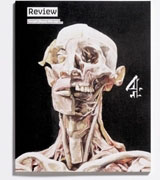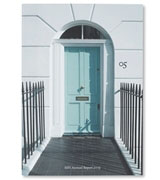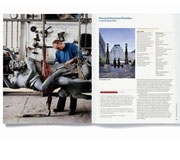Corporate challenge

Annual reports pose a perennial test for designers – how do you turn dry facts and figures into an attractive, effective document? Simon Esterson casts a critical eye over this year’s crop, but salvages some highlights
How do you want your annual report – a colourful marketing brochure or an authoritative black-and-white document? Two reports, each for a big plc and each well-designed in its own way, seem to characterise the different approaches.
For insurance giant Legal & General, Black Sun has taken the colourful, tightly copywritten, happy photograph route. Smiling employees sit – well, at least after a bit of Photoshop – on large numbers, accompanied by punchy statements such as, ‘Financial scale to build on’ and ‘Market presence to build on’. You get the idea. This kind of thing can be embarrassing – chief executives are not employed just because they take a great picture in the annual report. But here, Black Sun has made the approach work, partly because it has done it properly, but also because the structure around it is organised in an intelligent way. The opening financial highlights page is very clear, and this is followed by an illustration-based visual summary of the company, printed on different-sized pages on uncoated stock. In an annual report world of Swiss-style pie charts, these drawings are very different and refreshing. The group chief executive’s review is presented as a question-and-answer interview, which makes the text more accessible. Overall, it looks as though the copywriters and the designers actually talked to each other when this report was being conceived.
Over at building products multinational Hanson, Browns has gone in the opposite direction and made a classic annual report: sober, confident and restrained, in many ways looking back to a period before annual reports became over-designed. Black-and-white location photographs of senior managers, by Phil Sayer, are reportage in feel and deliberately unheroic (no standing on the edge of a roof with a flash in your face here), while pictures of massive machinery are used in the margin, rather than splashed over double-page spreads. The sans serif typography is beautifully detailed, with just a deep red spot colour for emphasis. The only tricks are some things going on with varnishes, and it has been very well printed by Westerham Press.

At furniture company MFI, the story is of ‘restructuring’ and ‘reinvigoration’ (which means bad news), but it’s told in a very calm way in SAS’s annual report, which has as much white space as any Minimalist kitchen. Photographs by Nick Guttridge of views through doorways make the point that ‘when one door closes, another door opens’. The directors, no doubt, hope it is the door of profitability.
SAS also designed the report for the BBA Group, which makes parts for aeroplanes and industrial fibres. Uncoated stock at front and back wraps a central matt art four-colour portfolio of photographs of the products by Benedict Redgrove. The uncoated pages use silver foil-blocking on the bar charts, which cleverly evokes both the metal of the aircraft and the precise characteristics of the components.
CDT Design has a 15-year history of producing annual reports for British Land. Together, they have pioneered the smart idea that you can use different kinds of images to tell a parallel story. This year’s report uses photographs commissioned from Cristian Barnett of conservation organisations at work and it is well printed by Fulmar Colour on a matt art stock. By contrast, Wechsler Ross & Portet has created a small-format, uncoated report for holiday village business Center Parcs. It uses chunky serif font Clarendon and lots of green pages, but no colour pictures, so it doesn’t look like a holiday brochure. The pictures of frogs and squirrels are as large as the pictures of the directors, but it gives a good, unpretentious impression of the company.
Williams & Phoa is an annual report specialist and its work for Royal Wessanen, a Netherlands-based food company, plays with the conventions: no photograph on the cover, but a series of magazine-like image spreads narrating the corporate message. Its three-column grid makes elegant pages and the designers have used a striking purple, orange and green colour palette in a sector where most companies opt for the predictable and safe. The annual report for Associated British Ports Holdings, designed by NB Studio and Merchant, uses reportage illustration by Lucinda Rogers, which somehow manages to be much more evocative than photography.

However, this is a rigorously unscientific selection, based on a big pile of reports with generally unimpressive contents. Some were just bad. Others seemed to be based on a template that is the ghost of earlier work by Cartlidge Levene or Williams & Phoa. I wouldn’t be the first person to think the annual report is going through a bad patch. But let’s not end on a negative note. Browns’ work for Channel 4 – its fourth – is outstanding. It’s the only really editorial-like project here and the decision to use illustration as the major element, instead of programme stills, means it doesn’t look like every other media company report – which I guess is the point.
Simon Esterson is founder of editorial design consultancy Esterson Associates
-
Post a comment




